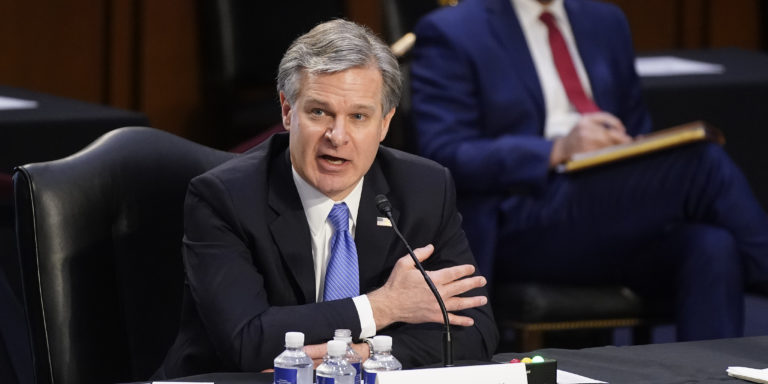INTELBRIEF
March 3, 2021
IntelBrief: FBI Director Wray Testifies Before Congress on Terrorism Threat in the U.S.

Bottom Line Up Front
- FBI Director Wray testified yesterday before Congress, saying he believed the siege of the U.S. Capitol constituted an act of domestic terrorism.
- Of the more organized actors involved with the January 6th insurrection, the “biggest bucket” is comprised of “militia violent extremists.”
- Over the past two years, the number of domestic terrorism investigations being pursued by the FBI have increased from 850 to approximately 2,000.
- The issue of the need for a domestic terrorism law in the U.S. was raised several times, with Director Wray noting it’s a “reasonable debate” to have.
FBI Director Christopher Wray testified yesterday before the United States Senate Judiciary Committee at a hearing entitled “Oversight of the Federal Bureau of Investigation: The January 6th Insurrection, Domestic Terrorism, and Other Threats.” During his testimony, Wray said that he believed the siege of the Capitol was not only criminal behavior, but constituted domestic terrorism. He went on to say that the insurrection would serve as inspiration for future attacks, given how it is perceived as a success in violent extremist circles. One major takeaway from the hearing was that racially and ethnically motivated violent extremism, particularly violent white supremacy extremism, continues to pose the most significant terrorism threat to the United States. Wray noted that white supremacy, in particular, “is the biggest chunk of our domestic terrorism portflio.” When pressed on what the FBI needed to combat the growing threat, Director Wray responded that the Bureau would benefit from more agents, more analysts, and more data analytics.
“We have not to date seen any evidence of anarchist violent extremists or people subscribing to Antifa in connection with the 6th,” Wray had to repeat in order to address several questions from Republican lawmakers about the role, if any, of Antifa in the storming of the U.S. Capitol. Meanwhile, there was little discussion about groups like the Oath Keepers and the Three Percenters, established militias groups that were present at the Capitol on that day. Of the more organized actors involved with the January 6th insurrection, the “biggest bucket” is tied to “militia violent extremism,” he said. These were individuals belonging to networks and groups that did coordinate with each other in preparation for the Capitol attack. Largely absent from the hearing was any substantive discussion of the QAnon conspiracy, although it has been well-documented that QAnon adherents played a significant role in the Capitol attack.
During Congressional testimony in March 2019, Wray noted that the FBI had approximately 850 domestic terrorism investigations underway. In 2021, that number has increased exponentially, to roughly 2,000 investigations in 55 out of 56 FBI field offices. In detailing the individuals who participated in the events at the Capitol on January 6th, Wray described an inverted pyramid, with peaceful protesters comprising the largest number of those involved. Next were people who attended the protest and were swept up in the momentum of the day, mostly engaged in low-level trespassing. Finally, the third group was the most threatening — those who breached the grounds of the Capitol and engaged in acts of violence. Significantly, this third group arrived with both the means and intent to commit acts of domestic terrorism, and they did so. This was blatantly reflected in photographs of insurrectionists carrying “zip ties” or threatening lawmakers, and in the bombs planted near Democratic and Republican Party headquarters.
Another aspect of today’s domestic terrorism threat is the phenomenon of “lone actors,” whether so-called homegrown violent extremists inspired by jihadist propaganda, or domestic violent extremists. Although the issue came up less in questions from lawmakers, Director Wray did make a point to include an assessment of the enduring nature of the threat posed by groups like al-Qaeda and the Islamic State in his highly detailed written testimony. Both groups continue to seek to attack the U.S. homeland directly, while also using propaganda to inspire homegrown violent extremists in the United States to lash out. Director Wray also underscored the threat posed by the Iran threat network, and made a point in his written testimony to reference the arrest several years ago of individuals in the United States “allegedly linked to Hizballah.”
Senator Lindsey Graham (R-SC) seemed open to the possibility of a domestic terrorism statute, equivalent to the legislation that the State Department uses to designate groups and organizations as foreign terrorist organizations (FTOs). Wray mentioned that there is a “reasonable debate” to be had over the merits of a domestic terrorism statute, a subject that has elicited passion on both sides of the debate throughout the counterterrorism and law enforcement community. Overall, the hearing was less focused than anticipated, especially given the severity of the events relating to January 6th. Some lawmakers focused on a situation report from the FBI’s Norfolk field office which warned of potential violence, seeking to understand why there was not a greater sense of urgency in preparing for what ultimately took place during the insurrection. Still, others used their time to ask questions only obliquely relevant to the events of January 6th, seemingly eager to deflect attention from what occured that day and how poorly it reflects on former President Trump. Despite the significance of violent white supremacy extremists and their growing linkages, there was only a brief mention of the interplay and connections between domestic and international terrorists. Especially, at a hearing of such import, there was a disappointing lack of attention devoted to what many in the counterterrorism field consider to be among the most pressing issues, such as the details of a strategy to counter the rise in domestic violent extremism in the United States.